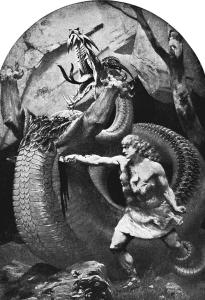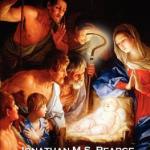Atheist anti-theist and “philosopher” Jonathan M. S. Pearce runs the blog, A Tippling Philosopher. He has encouraged me to visit his site and offer critiques, and wrote under a post dated 12-14-21: “I even need to thank the naysayers. Some of them have put up with a lot of robust pushback and still they come. Bravery or stupidity – it’s a fine line. But they are committed, and there is something to be said for taking that commitment into the lion’s den. Dave, you are welcome at my new place. Come challenge me. . . . thanks for your critiques of my pieces. Sorry I couldn’t get to more of them.” This echoes his words about me in a post dated 7-20-17, where he said, “well done . . . for coming here and suffering the slings and arrows of atheists’ wrath. . . . I commend him for getting involved and defending himself. Goodonya, mate.”
Under a post dated 1-27-22, he stated: “I do welcome disagreements because I don’t want [my blog] to [be] just an echo chamber. . . . [S]omeone like Armstrong does give me ammunition for some of my pieces!” Likewise, on 3-18-14 he proclaimed: “Dissenting views are utterly vital to being sure that you are warranted in your own beliefs and views.” And on 7-20-17: “I put my ideas and theories about the world out there for people to criticise. . . . I want to make damned sure that they are warranted. I can’t stand the idea that I could . . . believe something that is properly unwarranted. . . . What’s the point in self-delusion? . . . I put something out there, people attack it, and if it still stands, it’s pretty robust and I am happy to hold it. If not, I adapt and change my views accordingly.”
I’m delighted to oblige his wish to receive critiques and dissenting views! The rarity of his counter-replies, however, is an oddity and curiosity in light of this desire. He wrote, for example, on 11-22-19: “[I can’t be] someone who genuinely is not interested in finding out the truth about philosophy, God and everything. If I come up against any point that is even remotely problematic to my worldview, I feel the absolute necessity to bottom it out. I need to reconcile at least something; I have work to do. I cannot simply leave it as it is. . . . I would simply have to counter the arguments, or change my position.” Whatever; this hasn’t been my experience with him; only in short and infrequent spurts. I continue to offer them in any event, because they aren’t just for his sake.
Here’s what he thinks (by the way) of Jesus: “The Jesus as reported in the Gospels is so far removed from the real and historical figure of Jesus, overlaid with myth, story-telling, propaganda and evangelist agenda, that the end result is synonymous with myth. . . . I’d take mythicism over Christianity any day. And they call mythicists fringe as if the position is absurd? Now that’s crazy.” (8-2-14)
Jonathan’s words will be in blue.
*****
This is a reply to his article, Answers in Genesis and Dragons. Fact or Fiction? Er… fiction. (11-27-17).
Most of it is a lengthy citation of a fundamentalist piece, which appears to actually believe that dragons (i.e., dinosaurs) lived at the same time as man. That has nothing to do with what I write about or defend. I deal with serious, mainstream, intellectually cogent Christianity. Jonathan commented on it:
Probability-wise, it’s [the article he is critiquing] a shocker which depends on presupposing the truth of the Bible at any rate.
The Bible teaches no such thing, as I will shortly prove. The central issue here is what the Bible means by a “dragon.” There are reptiles today with the name dragon (e.g., bearded dragon, Chinese water dragon), but they are obviously not the fire-breathing mythical animals of folklore, fantasy, and fairy tale. It’s the same with the Bible.
New Bible Dictionary on “Behemoth” states that the word occurs nine times in the Old Testament, “and in all but one of these occurrences ‘beasts’, ‘animals’, or ‘cattle’ is apparently the intended meaning.” In Job 40:15, “the hippopotamus . . . seems to fit the description best.” The Catholic Encyclopedia (“Animals in the Bible”) agrees:
[G]enerally translated by “great beasts”; in its wider signification it includes all mammals living on earth, but in the stricter sense is applied to domesticated quadrupeds at large. However in Job 40:10, where it is left untranslated and considered as a proper name, it indicates a particular animal. The description of this animal has long puzzled the commentators. Many of them now admit that it represents the hippopotamus, so well known to the ancient Egyptians; it might possibly correspond as well to the rhinoceros.
No necessary interpretation of mythical animals here . . .
According to New Bible Dictionary, “Leviathan” in Psalms 104:26 is “generally thought to be the whale.” In Job 41:1-34, “most scholars” think it is a crocodile. In other instances, the use is clearly symbolic. Smith’s Bible Dictionary essentially concurs:
In the Hebrew Bible the word livyathan , which is, with the foregoing exception, always left untranslated in the Authorized Version, is found only in the following passages: ( Job 3:8 ; 41:1 ; Psalms 74:14 ; 104:26 ; Isaiah 27:1 ) In the margin of ( Job 3:8 ) and text of ( Job 41:1 ) the crocodile is most clearly the animal denoted by the Hebrew word. ( Psalms 74:14 ) also clearly points to this same saurian. The context of ( Psalms 104:26 ) seems to show that in this passage the name represents some animal of the whale tribe, which is common in the Mediterranean; but it is somewhat uncertain what animal is denoted in ( Isaiah 27:1 ) As the term leviathan is evidently used in no limited sense, it is not improbable that the “leviathan the piercing serpent,” or “leviathan the crooked serpent,” may denote some species of the great rock-snakes which are common in south and west Africa.
As for “dragons” in the Bible, Smith’s Bible Dictionary states:
The translators of the Authorized Version, apparently following the Vulgate, have rendered by the same word “dragon” the two Hebrew words tan and tannin, which appear to be quite distinct in meaning.
-
The former is used, always in the plural, in ( Job 30:29 ; Psalms 44:19 ; Isaiah 34:13 ; 43:20 ; Jeremiah 9:11 ) It is always applied to some creatures inhabiting the desert, and we should conclude from this that it refers rather to some wild beast than to a serpent. The Syriac renders it by a word which, according to Pococke, means a “jackal.”
-
The word tannin seems to refer to any great monster, whether of the land or the sea, being indeed more usually applied to some kind of serpent or reptile, but not exclusively restricted to that sense. ( Exodus 7:9 Exodus 7:10 Exodus 7:12 ; 32:33 ; Psalms 91:13 )
The Catholic Encyclopedia (“Animals in the Bible”) has an excellent treatment of “dragon”:
It stands indeed for several Hebrew names:
- (1) thán (Job 30:29; Isaiah 34:13; 35:7; 43:20; Jeremiah 9:11; 10:22; 14:6; 49:33; 51:37; Micah 1:8; Malachi 1:3), unquestionably meaning a denizen of desolate places, and generally identified with the jackal;
- (2) tánnîm, in a few passages with the sense of serpent [Deuteronomy 32:33; Psalm 90:13; Daniel 14:22-27), in others most likely signifying the crocodile [Psalm 73:13; Isaiah 51:9; Ezekiel 29:3], or even a sea-monster (Ezekiel 32:2), such as a whale, porpoise, or dugong, as rightly translated Lamentations 4:3, and as probably intended Psalm 148:7;
- (3) líweyãthãn (leviathan), meaning both the crocodile [Psalm 73:14] and sea-monster [Psalm 103:26];
- (4) çiyyim (Psalm 73:14; Jeremiah 1:39), which possibly means the hyena.
Other places, such as Esther 10:7; 11:6; Ecclesiasticus 25:23, can be neither traced back to a Hebrew original, nor identified with sufficient probability. . . . Of the fabulous dragon fancied by the ancients, represented as a monstrous winged serpent, with a crested head and enormous claws, and regarded as very powerful and ferocious, no mention whatever is to be found in the Bible. The word dragon, consequently, should really be blotted out of our Bibles, except perhaps Isaiah 14:29 and 30:6, where the draco fimbriatus is possibly spoken of.
The word itself doesn’t have to necessarily refer to a mythical creature, and scientists at the time of the King James Version in 1611 referred to large serpents as “dragons.” Wikipedia in its article on dragons provides the etymology:
The word dragon entered the English language in the early 13th century from Old French dragon, which in turn comes from Latin: draconem (nominative draco) meaning “huge serpent, dragon”, from Ancient Greek δράκων, drákōn (genitive δράκοντος, drákontos) “serpent, giant seafish”. The Greek and Latin term referred to any great serpent, not necessarily mythological.
“Flying serpents” are mentioned in Isaiah 14:29, and “fiery serpents” in Numbers 21:6-8. Wikipedia has an excellent article, “Fiery flying serpent” that lists all these passages and provides an altogether adequate and plausible explanation (see further source information there):
Ronald Millett and John Pratt identify the fiery serpent with the Israeli saw-scale viper or carpet viper (Echis coloratus) based on ten clues from the written sources: the serpents inhabit the Arava Valley, prefer rocky terrain, are deadly poisonous, extremely dangerous, especially painful “fiery” bite, reddish “fiery” color, lightning fast strike, leaping/”flying” strike, and death by internal bleeding. A Roman account dated 22 AD about the deserts of Arabia indicates the presence of the saw-scale viper, reporting that “there are snakes also of a dark red color, a span in length, which spring up as high as a man’s waist, and whose bite is incurable.” Other candidates include desert horned viper (and close relatives) and the desert black snake or black desert cobra.
Wikipedia, “Serpents in the Bible” / section: “Fiery serpents” provides more relevant information:
“Fiery serpent” (Hebrew: שָׂרָף, Modern: saraph, Tiberian: sä·räf’, “fiery”, “fiery serpent”, “seraph”, “seraphim”) occurs in the Torah to describe a species of vicious snakes whose poison burns upon contact. According to Wilhelm Gesenius, saraph corresponds to the Sanskrit Sarpa (Jawl aqra), serpent; sarpin, reptile (from the root srip, serpere). These “burning serpents” infested the great and terrible place of the desert wilderness (Num.21:4-9; Deut.8:15). The Hebrew word for “poisonous” literally means “fiery”, “flaming” or “burning”, as the burning sensation of a snake bite on human skin, a metaphor for the fiery anger of God (Numbers 11:1)
The ancient Greeks and Romans, on the other hand, believed in a huge number of mythical animals. For example, Pliny the Elder (AD 23–79), the Roman author, naturalist, and natural philosopher, wrote the 37-volume Naturalis Historia (Natural History), which became an editorial model for encyclopedias. Book 8, devoted to land animals, contained information about legendary creatures such as the Manticore, Basilisk, and Werewolf. He opined about the second:
It is produced in the province of Cyrene, being not more than twelve fingers in length. It has a white spot on the head, strongly resembling a sort of a diadem. When it hisses, all the other serpents fly from it: and it does not advance its body, like the others, by a succession of folds, but moves along upright and erect upon the middle. It destroys all shrubs, not only by its contact, but those even that it has breathed upon; it burns up all the grass, too, and breaks the stones, so tremendous is its noxious influence.
Pliny was the first to describe a mythical animal called the catoblepas “as a mid-sized creature, sluggish, with a heavy head and a face always turned to the ground. He thought its gaze, like that of the basilisk, was lethal, . . .” Herodotus, Ovid, and Virgil all wrote seriously about werewolves. Pliny “describes the [phoenix] as having a crest of feathers on its head” and Tacitus thought its color “made it stand out from all other birds.”
Jonathan Pearce and many atheists seem to assume that the Bible teaches similarly. It does not. The ancient Hebrews, being a far more sophisticated and advanced culture than the Greeks or Romans in this respect, did not believe in mythical animals, as has just been demonstrated. We see that yet another of the innumerable atheist bashings of the Bible is groundless.
For some curious reason, Jonathan never mentioned that the ancient Greeks and Romans believed in all these mythical animals (that doesn’t fit the “plan” of his polemics, you see). All he can do is quote fringe Christian fundamentalists and pretend that they accurately pass along biblical teachings and represent mainstream Christianity. Shame on him.
***
Practical Matters: Perhaps some of my 4,000+ free online articles (the most comprehensive “one-stop” Catholic apologetics site) or fifty books have helped you (by God’s grace) to decide to become Catholic or to return to the Church, or better understand some doctrines and why we believe them.
Or you may believe my work is worthy to support for the purpose of apologetics and evangelism in general. If so, please seriously consider a much-needed financial contribution. I’m always in need of more funds: especially monthly support. “The laborer is worthy of his wages” (1 Tim 5:18, NKJV). 1 December 2021 was my 20th anniversary as a full-time Catholic apologist, and February 2022 marked the 25th anniversary of my blog.
PayPal donations are the easiest: just send to my email address: [email protected]. You’ll see the term “Catholic Used Book Service”, which is my old side-business. To learn about the different methods of contributing, including 100% tax deduction, etc., see my page: About Catholic Apologist Dave Armstrong / Donation Information. Thanks a million from the bottom of my heart!
***
Photo credit: Richard Wagner’s opera Siegfried; Siegfried slays the dragon. From the painting by Delitz; The Victrola book of the opera : stories of one hundred and twenty operas with seven-hundred illustrations and descriptions of twelve-hundred Victor opera records [public domain / Wikimedia Commons]
***
Summary: Anti-theist atheist Jonathan MS Pearce sez that the Bible teaches the existence of (fire-breathing?) dragons who lived at the same time as man. Once again, he’s wrong.














